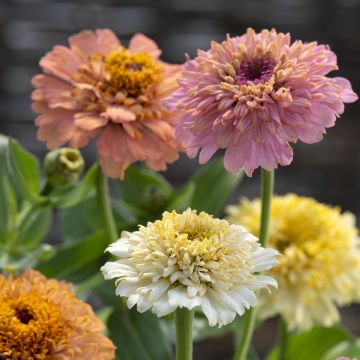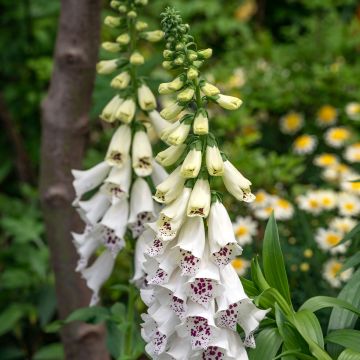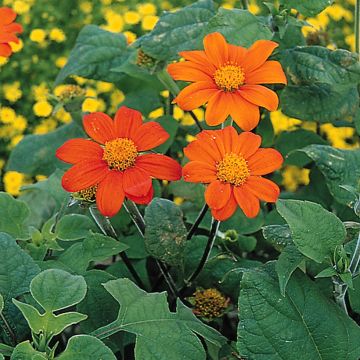

Zinnia marylandica Double Zahara Strawberry Seeds
Zinnia marylandica Double Zahara Strawberry Seeds
Zinnia marylandica Double Zahara Strawberry
Zinnia
I have a small problem, I only found 4 seeds in the packet??
sandrine, 20/04/2020
Special offer!
Receive a €20 voucher for any order over €90 (excluding delivery costs, credit notes, and plastic-free options)!
1- Add your favorite plants to your cart.
2- Once you have reached €90, confirm your order (you can even choose the delivery date!).
3- As soon as your order is shipped, you will receive an email containing your voucher code, valid for 3 months (90 days).
Your voucher is unique and can only be used once, for any order with a minimum value of €20, excluding delivery costs.
Can be combined with other current offers, non-divisible and non-refundable.
Home or relay delivery (depending on size and destination)
Schedule delivery date,
and select date in basket
This plant carries a 6 months recovery warranty
More information
We guarantee the quality of our plants for a full growing cycle, and will replace at our expense any plant that fails to recover under normal climatic and planting conditions.
Would this plant suit my garden?
Set up your Plantfit profile →
Description
Zinnia marylandica Double Zahara Strawberry offers an exceptionally long flowering period and is one of the best double, dwarf varieties. Its pompom-like blooms come in a very vivid, strawberry shade and are produced in abundance on compact, disease-resistant plants. Its flowers exude a peculiar scent which recalls that of polish, and are very beautiful in fresh or dry bouquets. Perfectly heat and drought-tolerant, this annual needs little maintenance, but requires sun and well-drained soil for best results.
Zinnia marylandica is a sterile hybrid belonging to the family Asteraceae, obtained by artificially crossbreeding Z. angustifolia var. angustifolia and Z. violacea. Both are native to northern and western Mexico. The cultivar 'Double Zahara Strawberry' is an annual plant that forms a rather slow-growing, compact, branched clump measuring 45 cm in height and in width, that requires no staking. The sturdy stems are covered with rough, downy, lanceolate to elliptical, medium green leaves. They flower from June-July to September-October and the blooms are nectar-rich and melliferous. The flower is a large, fully double, hemispherical capitulum composed of numerous ligulate flowers of a very bright pink, almost red hue, and recall the blooms of certain dahlias.
Seeing zinnias grow is always a lovely surprise. Not only are they able to sprout up from the ground in the most unlikely places, including those disdained by many plants, they are capable of blooming even in gravelly soils and in scorching sunlight. Their vivid, almost aggressive colours blend so well with the light of the relentless summer sun and pale gravel beaches, that they should be grown right into the cracks of the terrace or the paths. Even if they live only one year, you might as well take advantage of their never-ending blooming as much as you can. They assert themselves in cottage-style flowerbeds, where their fieriness is tempered by milder blooms of plants such as white or blue love-in-a-mist, cosmos, white gauras, or by placing them between airy grasses such as Stipa tenuifolia or Eragrostis trichoides. They can also be sown in pots to decorate the terrace in summer.
Report an error about the product description
Flowering
Foliage
Plant habit
Botanical data
Zinnia
marylandica
Double Zahara Strawberry
Asteraceae
Zinnia
Cultivar or hybrid
Other Zinnia seeds
View all →Planting and care
Direct sow zinnia seeds outdoors in their final positions, in April-May once the soil is warm. Choose a sunny position, on moist, well-drained soil that has been raked to a fine tilth. Sow seeds at a depth of 3 mm, in holes 30 cm apart. Water regularly, especially during dry periods. Germination usually takes 7 to 14 days. When zinnia seedlings are large enough to be handled, thin them out to 23 cm apart. You can also sow them indoors from March to April at a temperature of 15-25 °C. After sowing, keep the surface of the soil moist but not waterlogged and expose to the light as this helps germination. When the seedlings are large enough to be handled, transplant them and grow them on in cooler conditions. When the plants are well grown, and all risk of frost has passed, gradually acclimatize them to outdoor conditions for 10-15 days before planting outdoors in their final location. Zinnias are easy to grow in the sun, in fairly rich, well-drained soils.
Sowing period
Intended location
-
, onOrder confirmed
Reply from on Promesse de fleurs
Similar products
Haven't found what you were looking for?
Hardiness is the lowest winter temperature a plant can endure without suffering serious damage or even dying. However, hardiness is affected by location (a sheltered area, such as a patio), protection (winter cover) and soil type (hardiness is improved by well-drained soil).

Photo Sharing Terms & Conditions
In order to encourage gardeners to interact and share their experiences, Promesse de fleurs offers various media enabling content to be uploaded onto its Site - in particular via the ‘Photo sharing’ module.
The User agrees to refrain from:
- Posting any content that is illegal, prejudicial, insulting, racist, inciteful to hatred, revisionist, contrary to public decency, that infringes on privacy or on the privacy rights of third parties, in particular the publicity rights of persons and goods, intellectual property rights, or the right to privacy.
- Submitting content on behalf of a third party;
- Impersonate the identity of a third party and/or publish any personal information about a third party;
In general, the User undertakes to refrain from any unethical behaviour.
All Content (in particular text, comments, files, images, photos, videos, creative works, etc.), which may be subject to property or intellectual property rights, image or other private rights, shall remain the property of the User, subject to the limited rights granted by the terms of the licence granted by Promesse de fleurs as stated below. Users are at liberty to publish or not to publish such Content on the Site, notably via the ‘Photo Sharing’ facility, and accept that this Content shall be made public and freely accessible, notably on the Internet.
Users further acknowledge, undertake to have ,and guarantee that they hold all necessary rights and permissions to publish such material on the Site, in particular with regard to the legislation in force pertaining to any privacy, property, intellectual property, image, or contractual rights, or rights of any other nature. By publishing such Content on the Site, Users acknowledge accepting full liability as publishers of the Content within the meaning of the law, and grant Promesse de fleurs, free of charge, an inclusive, worldwide licence for the said Content for the entire duration of its publication, including all reproduction, representation, up/downloading, displaying, performing, transmission, and storage rights.
Users also grant permission for their name to be linked to the Content and accept that this link may not always be made available.
By engaging in posting material, Users consent to their Content becoming automatically accessible on the Internet, in particular on other sites and/or blogs and/or web pages of the Promesse de fleurs site, including in particular social pages and the Promesse de fleurs catalogue.
Users may secure the removal of entrusted content free of charge by issuing a simple request via our contact form.
The flowering period indicated on our website applies to countries and regions located in USDA zone 8 (France, the United Kingdom, Ireland, the Netherlands, etc.)
It will vary according to where you live:
- In zones 9 to 10 (Italy, Spain, Greece, etc.), flowering will occur about 2 to 4 weeks earlier.
- In zones 6 to 7 (Germany, Poland, Slovenia, and lower mountainous regions), flowering will be delayed by 2 to 3 weeks.
- In zone 5 (Central Europe, Scandinavia), blooming will be delayed by 3 to 5 weeks.
In temperate climates, pruning of spring-flowering shrubs (forsythia, spireas, etc.) should be done just after flowering.
Pruning of summer-flowering shrubs (Indian Lilac, Perovskia, etc.) can be done in winter or spring.
In cold regions as well as with frost-sensitive plants, avoid pruning too early when severe frosts may still occur.
The planting period indicated on our website applies to countries and regions located in USDA zone 8 (France, United Kingdom, Ireland, Netherlands).
It will vary according to where you live:
- In Mediterranean zones (Marseille, Madrid, Milan, etc.), autumn and winter are the best planting periods.
- In continental zones (Strasbourg, Munich, Vienna, etc.), delay planting by 2 to 3 weeks in spring and bring it forward by 2 to 4 weeks in autumn.
- In mountainous regions (the Alps, Pyrenees, Carpathians, etc.), it is best to plant in late spring (May-June) or late summer (August-September).
The harvesting period indicated on our website applies to countries and regions in USDA zone 8 (France, England, Ireland, the Netherlands).
In colder areas (Scandinavia, Poland, Austria...) fruit and vegetable harvests are likely to be delayed by 3-4 weeks.
In warmer areas (Italy, Spain, Greece, etc.), harvesting will probably take place earlier, depending on weather conditions.
The sowing periods indicated on our website apply to countries and regions within USDA Zone 8 (France, UK, Ireland, Netherlands).
In colder areas (Scandinavia, Poland, Austria...), delay any outdoor sowing by 3-4 weeks, or sow under glass.
In warmer climes (Italy, Spain, Greece, etc.), bring outdoor sowing forward by a few weeks.



















































